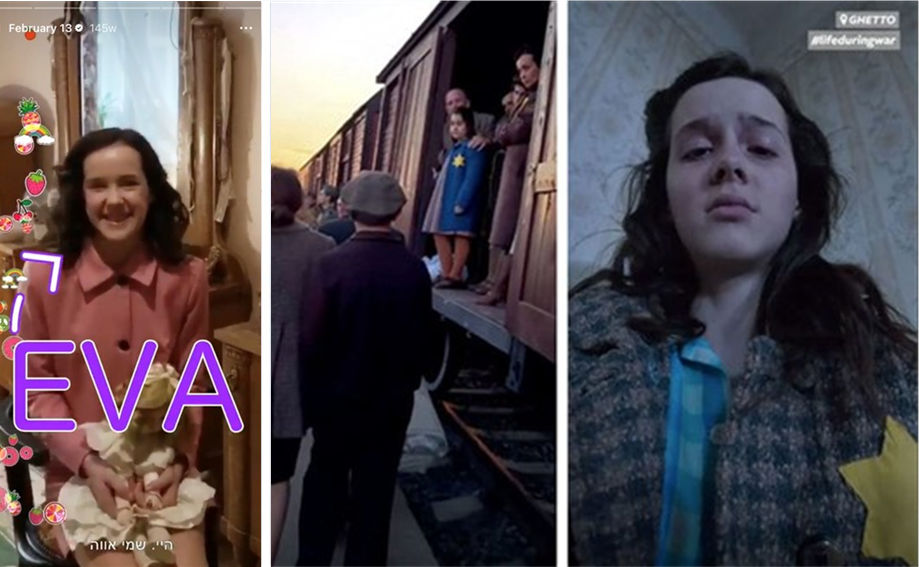“What if a girl in the Holocaust had Instagram?”
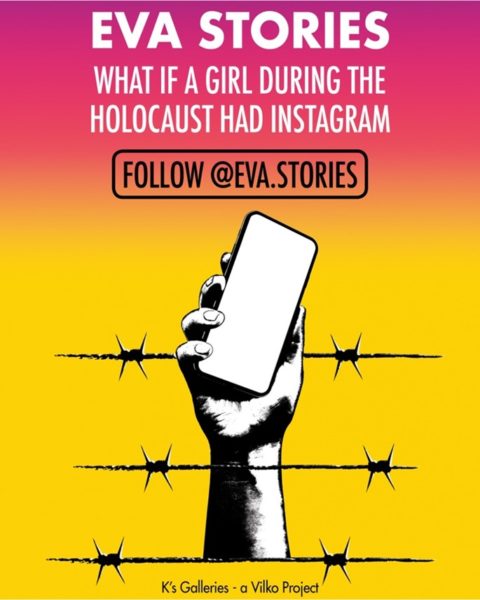
The Instagram account @eva.stories is a social media project produced by Israeli tech entrepreneur Mati Kochavi. It launched on May 1, 2019, the day before Yom HaShoah, Israel’s annual Holocaust Martyrs’ and Heroes’ Remembrance Day. Across 24 hours, 70 “Stories” were posted covering four months of Eva’s life from February 13, when she received the diary, to May 1944. The project culminated in her transport to Auschwitz in June 1944. Designated a “personal blog,” the account exists as an archive on Instagram. Thirty-one Story Highlights can be watched on demand.
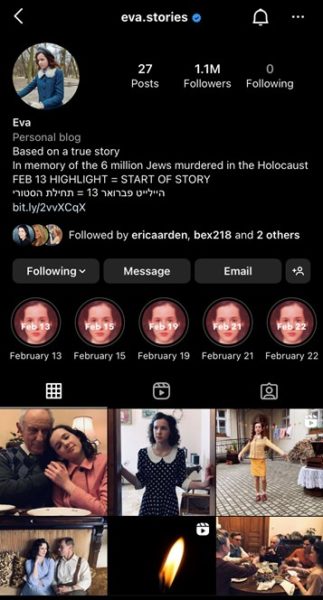
@eva.stories goes to great lengths to situate the events in 1940s Europe, with period-appropriate costumes, hair, makeup, and set design. It foregrounds distinct Instagram aesthetics such as animated GIFs, boomerangs, emojis, filters, and location tags and in the actors’ direct address to the smartphone camera. It’s Anne Frank’s “The Diary of a Young Girl” (1947) reworked for the social media generation.
@eva.stories is based on the wartime diary of Eva Heyman, a 13-year-old Jewish girl who lived with her assimilated bourgeois family in the Hungarian border city of Nagyvárad. She died in Auschwitz. Using Instagram’s popular Stories feature, it invents a scenario where she had a smartphone, cellular data, and an Instagram account rather than pen and paper.
The short sequences range from 30 seconds to six minutes. A fictionalized Eva chronicles her life with her smartphone camera and shares her Stories on her public Instagram page. She transforms from a diarist into an Instagrammer.
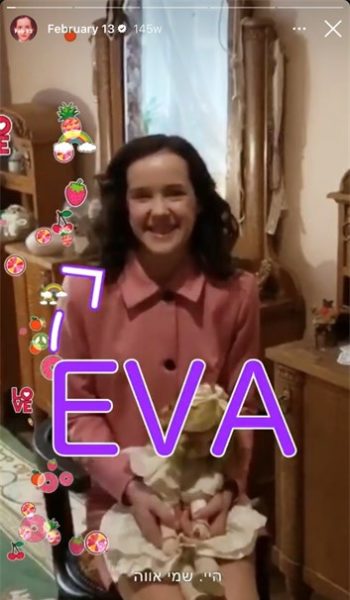
The first Story opens with Eva’s voice-over. She shares Nazis have conquered most of Europe and “do terrible things to us Jews.” She believes the Russian Army will stop the German forces before they reach the Hungarian border. She dreams about moving to the city to become a reporter. Drawings, photographs, and moving images detail her glamorous mother in Budapest, her grandparents, and her “BFF” Annie, who “dances just like Josephine Baker.”
Filters, text, stickers, and GIF emojis mark her self-expression. Eva serves as reporter and historical witness posting testimony to her Instagram followers.
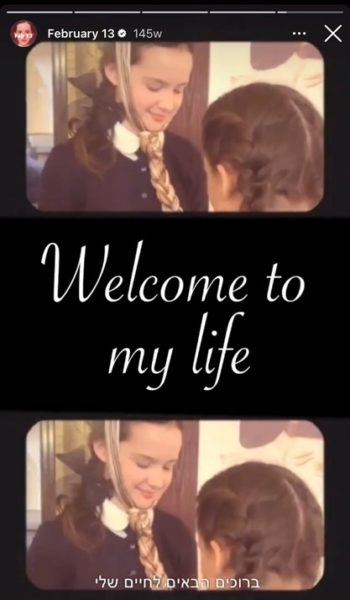
Universal Victimhood
The post-World War II era struggled over how to approach Nazi atrocities. Anne Frank’s “Diary of a Young Girl” offered a solution and shaped international public consciousness of the Holocaust.
In 1952, the English-language translation became a bestseller in the United States and the diary was adapted into a television drama and a radio play. Throughout the 1950s, the story of Anne Frank amassed enormous popularity internationally. It inspired successful books and a Broadway play (1956). George Stevens’s “The Diary of Anne Frank” (1959) introduced many tropes of Holocaust cinema and popularized conventions about the image of Anne.
Writing about this “Anne Frank phenomenon,” Barbara Kirshenblatt-Gimblett and Jeffrey Shandler dissect her universal appeal as an amalgam of identities such as young girl, victim, archetypal Jew, diarist, adolescent, feminist. These configurations universalize Jewish victimhood and elevate Anne’s image as the representative victim of the Holocaust.
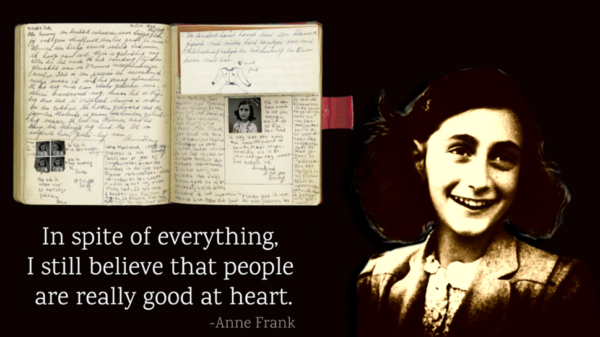
@eva.stories extends familiar renderings of universal victimhood to our current moment where anxieties over the future of Holocaust remembrance looms large. The popular culture image of Anne Frank raises questions about Holocaust memory in the post-witness era, as those who lived through it are dying.
Context is critical. A 2020 survey reveals millenials and Gen Z lack basic Holocaust knowledge. A new wave of antisemitism sweeps across the globe as the Kanye West utterance indicates. As a result, new urgencies about how to keep Holocaust memory alive have emerged.
Digitizing the Holocaust
Digital media technologies, the internet, and social media have propelled discussions around Holocaust memory in the post-witness era. Their ubiquity has contributed to a massive shift in Holocaust education, research, and commemoration. James E. Young identifies this as a movement from living to mediated memory.
Digital and online initiatives preserve and transmit Holocaust history and memory to new generations. Official archives, museums, and memorials have embraced the internet to extend access to archival and library materials as critical educational, historical, and cultural work.
Since 2009, the Fortunoff Video Archive for Holocaust Testimony at Yale University has made its expansive collection of digitized audiovisual testimonies with Holocaust survivors and witnesses available on its website with a searchable database. The USC Shoah Foundation’s Dimensions in Testimony Project records interviews with survivors on a 3-D capture stage to create interactive holographic testimonies. AI and ASR software help to answer questions.
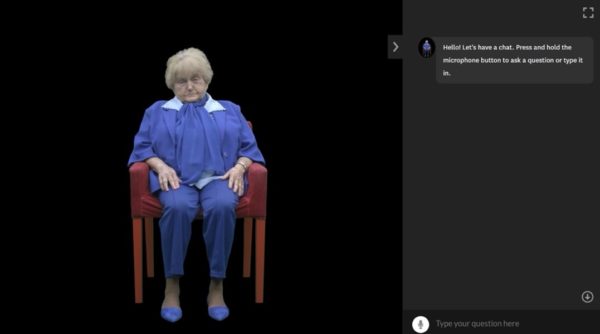
Facebook, Instagram, TikTok, Twitter, and YouTube are increasingly important tools for institutional Holocaust memorialization and education. Holocaust-related educational institutions such as the Auschwitz Memorial and Museum, the United States Holocaust Memorial Museum, and Yad Vashem have been active on a variety of social media platforms since the mid-2000s. They curate their own official Instagram accounts.
Closing the Distance
Holocaust scholars largely focus on how digital technologies and social media practices galvanize new forms of immersion, interactivity, and participation to engage Holocaust histories and memories.
But interactive modes of engagement are not the whole story. The revitalization of established cinematic treatments of the Holocaust in @eva.stories suggests analysis into how old tropes and new interfaces intertwine is necessary.
@eva.stories adopts Instagram-specific visual strategies such as a vertical frame to close the historical distance between the social media present and the imagined past.
First, it deploys what Tim Highfield and Tama Leaver call “Instagrammatics” such as filters, text, stickers, and GIF emojis.
Second, it appropriates social media’s selfie aesthetic. This strategy frames the project as testimonial, a first-hand account of Eva’s personal experience of historical events. It explicitly connects to the act of bearing witness.
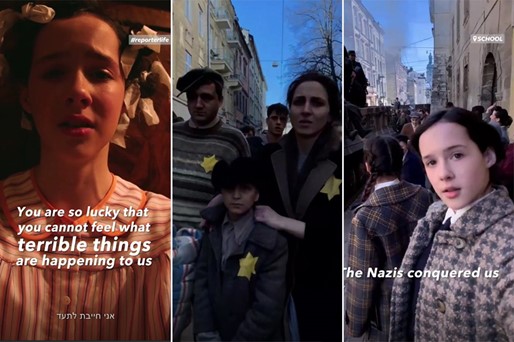
The witness has special import for Holocaust commemoration and education in the post-Holocaust era, which Annette Wieviorka characterizes as “the era of the witness.” Witness testimony occupies a privileged status as a viable cinematic treatment.
Consider landmark Holocaust documentaries such as Claude Lanzmann’s 9 ½-hour “Shoah” (1985). The documentary invests in the transformative presence of witness testimony and refuses visualization through archival footage or reenactment. The film positions itself against fictional imaginings.
“Shoah” continues to inform Holocaust visualities. Yet these debates reduce moral and ethical debates around Holocaust representation down to a simplistic opposition of to show or not to show. This hierarchy of acceptable Holocaust representations reproduces old binaries between high and low art.
Melodrama and Fictionalizing History
Countering critics who emphasize the distinct ways @eva.stories mediates Holocaust memory through Instagram, this Holocaust encounter is not simply Instagram’s visual aesthetics remediating new styles of engagement. It’s something else entirely: melodrama’s dramatic strategies activate the hinge between the personal and the historical.
@eva.stories’s visual strategies, narrative structure, and thematic preoccupations blend together a fictional representation of history and a mediation of Holocaust memory. This process relies on melodrama’s personalization of suffering and engagement with abstract historical forces.
Eva epitomizes an innocent victim of the Nazi regime unable to change her fate. Iconic visual imagery of the Holocaust such as Nazi troops, yellow Star of David badges, crowded train cars, and more reinforce this historical narrative.
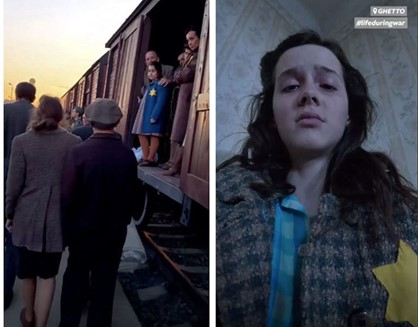
Fictional films about the Holocaust have been criticized for encouraging identification with suffering victims. On the other hand, digital and social media are celebrated for creating personal connections and engendering empathy with lived experiences of the Holocaust. Although the melodrama’s imbrication of affect and pathos has often been dismissed as a sentimental emotional manipulation, the genre is important.
The divisions between interactivity and representation, empathy and pathos, and history and memory mirror tensions between witness testimonies and melodramatic fictional representations of the Holocaust. These rifts ripple through @eva.stories.
First-Person Selfie Politics
@eva.stories points to a new development in Holocaust representation where social media self-representation reframes fictional representations of the historical past.
First-person selfie-style summons testimony and witnessing aesthetics. These social media fictional representations are perplexing because they fuse highly scripted, stylized commercial projects with social media claims of authenticity and immediacy.
In August 2022, the Anne Frank House, a site-specific museum housed in the space where Anne hid and wrote her diary, released a sequel to its 15-episode web series “Anne Frank Video Diary” (2020) on its official YouTube channel. It asks “what if Anne Frank had a camera instead of a diary?.” The original web series depicts her as a vlogger sharing her life from the secret annex.
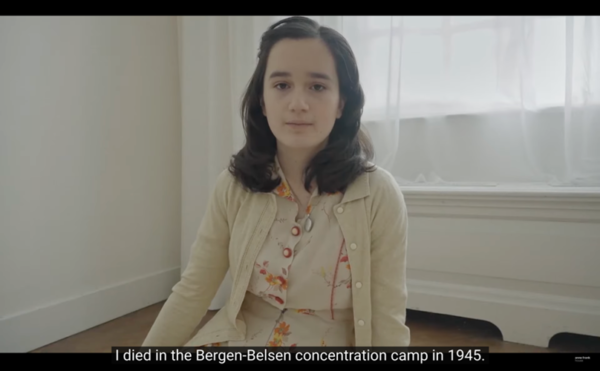
Like @eva.stories, the YouTube series updates Anne’s diary to appeal to children, teenagers, and young adults on social media.
“Anne Frank – After the Arrest” (2022) imagines what happened to Anne after she stopped writing her diary. She faces the smartphone camera and speaks from beyond the grave, stating “I’m Anne. I died in the Bergen-Belson concentration camp in 1945.” Anne exists beyond space and time, an apparition.
Resonating with @eva.stories, the selfie aesthetic anchors the video in personal experiences of historical events.
Unlike @eva.stories, an official institution produced this project to be housed on a more conventional streaming platform.
From different ends of the representational spectrum, both projects rouse urgent, unresolved questions about social media aesthetics and politics in Holocaust memorialization.
Rachel Schaff is Assistant Professor of Media Studies at Mercer University in Georgia and Associate Producer of the Finger Lakes Environmental Film Festival (FLEFF). She has published in Afterimage, Cinema et Cie, Nineteenth Century Theatre and Film, The Spectator, Screen, and Studies in Eastern European Cinema. She researches melodrama and Holocaust memorialization across cinematic forms and national contexts.

